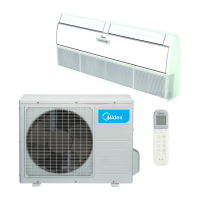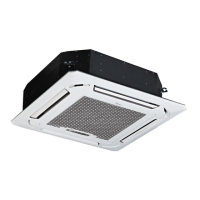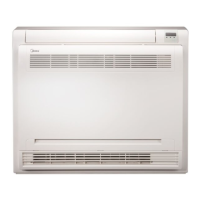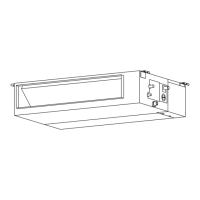4
owner's manual
NOTE
NOTE
3. OPERATING INSTRUCTIONS
The above illustration is for explanation purpose only.
The features are different depending on models.
3.1 UNIT CONTROL PANEL
ou can not select a fan speed under AUTO and DRY mode.
The fan motor operates at pre-set AUTO speed under AUTO
mode and at LOW speed under DRY mode.
Select LOW fan speed and the first zone will illuminate;
Select AUTO fan speed and zones 1~2 will illuminate;
Select HIGH fan speed and zones 1~3 will illuminate.
Once selected, after 2 seconds the zones will illuminate gradually
based on the speed selected.
For example, HIGH fan speed will show the display illuminating
quickly from zone to zone.
Operation starts when this button is pressed
and stops when you press the button again.
1
1
2
3
4
5
6
7
Operation buttons
Indicators
ON/OFFbutton:
Press this button to select the appropriate
operating mode. Each time the button is pressed, the operation
mode is shifted in the direction of the arrow:
Mode indicators illuminates under the different mode settings.
2
MODEbutton:
Automatically choose the operation mode by sensing
the difference between the actual ambient room temperature
and the set temperature on the remote controller. The fan
speed is automatically controlled.
Auto:
Enables you to enjoy the cooling effect at you
preferred setting temperature.
(Temperature range:17
℃
~30
℃
)
Cool:
Enables you to set the desired temperature at low fan
speed which provides you with the dehumidifying surroundings
(Temperature range:17OC~30OC). In Dry mode, you can not
select Fan speed.
Dry:
Permits heating operation(For cooling & heating
models only)
(Temperature setting range:17
℃
~30
℃
)
Heat:
Permits fan operation without cooling or heating.
In this case, however, the setting temperature is not displayed
and you can not adjust the set temperature.
Fan only:
AUTO COOL DRY HEAT(for cooling & heating models only) FAN ONLY
This button is used to select the
desired fan speed. Each time you push the button, a fan speed
is shifted in the direction of the arrow:
3
FAN SPEED button:
Use this button to select
or cancel the auxiliary feature.Press this button, then press the
ADJUST"▲"and"
▲
"button to select the desired feature. Each
time the button is pressed, the mode is shifted in the direction of
the arrow:
When press the "▲" button:
When press the "
▲
" button:
Once the desired feature is established, press the AUXILIARTY
FUNCTION button again to register .
5
AUXILIARY FUNCTION button:
Enables you to set the desired
horizontal airflow direction.
Left/Right airflow:
Choose this feature to go into the
energy-saving operation. It is only available on Cool, Heat or
Auto mode. Under Sleep mode, the air conditioner will
automatically increase(cooling) or decrease(heating) 1
℃
per
hour. The set temperature will be stable 2 hours later. The fan
speed is forced AUTO.
Sleep operation:
Temperature adjust: Press the "▲"and"
▲
" to adjust the
temperature in a range of 17
℃
~30
℃
.
Timer adjust: Adjust the timer on/off time under the Timer
setting mode(0~24hs).
Auxiliary function selection: Select the desired auxiliary function
by pressing "▲"and"
▲
" button.
Under the Test Running mode, press "▲"and"
▲
"to check
information about T1, T2, T3, P4 , P5 and P9 (if no protection
function occurs, the code is shifted).
Under malfunction condition: Press the "▲"and"
▲
" to check the
malfunction code E1,E2, E3 ,E6 and E9(details refer to
TROUBLESHOOT in page 12).
1
2
3
4
5
4
ADJUST button:
The display is separated into 3
zones. When setting the speed, the corresponding zone will
illuminate.
Fan speed displaying:
LOW HIGH AUTO
Relative indicator lights up under the different
mode settings:
Fan speed display
Auto operation display
Fan operation display
Heating operation display
Dry operation display
Cooling operation display
Lock operation display
Sleep operation display
On timer operation display
Off timer operation display
Turbo operation display
Swing operation display
Table 3-1
Fig.3-1

